CBSE Class 12 Biology Molecular Basis of Inheritance VBQs read and download in pdf. Value Based Questions come in exams for Biology in Class 12 and are easy to learn and helpful in scoring good marks. You can refer to more chapter wise VBQs for Class 12 Biology and also get latest topic wise very useful study material as per latest NCERT book for Class 12 Biology and all other subjects for free on Studiestoday designed as per latest Class 12 CBSE, NCERT and KVS syllabus and examination pattern
VBQ for Class 12 Biology Chapter 5 Molecular Basis of Inheritance
Class 12 Biology students should refer to the following value based questions with answers for Chapter 5 Molecular Basis of Inheritance in Class 12. These VBQ questions with answers for Class 12 Biology will come in exams and help you to score good marks
Chapter 5 Molecular Basis of Inheritance VBQ Questions Class 12 Biology with Answers
Question. Hershey and Chase used 35S and 32P to prove that DNA is the genetic material. Their experiments proved that DNA is genetic material because
(a) progeny viruses retained 32P but not 35S
(b) retention of 32P in progeny viruses indicated that DNA was passed on
(c) loss of 35S in progeny viruses indicated that proteins were not passed on
(d) All of the above
Answer : D
Question. RNA is the genetic material in
(a) All bacteria
(b) Tobacco Mosaic Viruses (TMV)
(c) QB bacteriophage
(d) Both (b) and (c)
Answer : D
Question. In some viruses, the flow of information is in reverse direction, i.e. from RNA to DNA. Can you suggest a simple name to the process?
(a) Transcription
(b) Transception
(c) Reverse transcription
(d) Translation
Answer : C
Question. Promoter and terminator flanks the
(a) house-keeping gene
(b) structural gene
(c) recon
(d) transcription unit
Answer : B
Question. The presence of an adapter molecule that would on one hand read the code and on other hand would bind to specific amino acids was postulated by
(a) Francis Crick
(b) James Watson
(c) Rosalind Franklin
(d) Griffith
Answer : A
Question. Before the genetic code was postulated, the tRNA was called
(a) rRNA (ribosomal RNA)
(b) mRNA (messenger RNA)
(c) sRNA (soluble RNA)
(d) sRNA (sedimentary RNA)
Answer : C
Question. Study the given figure and identify A to F. (Image 122)
(a) A–Variable arm, B–D-loop, C–T-loop, D–Anticodon arm, E–Codon, F–Variable arm
(b) A–Amino acid arm, B–T-loop, C–Variable arm, D–Anticodon arm, E–Codon, F–D- loop
(c) A–Amino acid arm, B–T-loop, C–Anticodon loop, D–Anticodon, E–Codon, F–D-loop
(d) A–Amino acid arm, B–T-loop, C–Anticodon loop, D–Anticodon, E–Codon, F–Variable arm
Answer : C
Question. Choose the incorrect pair.
(a) Promoter — Binding site for RNA polymerase
(b) Terminator — Define the end of transcription process
(c) Cistron — Segment of RNA coding for a polypeptide
(d) Regulatory genes — Do not code for any RNA or protein
Answer : C
Question. In bacteria, which enzyme catalyses the transcription of all types of RNA (mRNA, tRNA and rRNA)?
(a) DNA-dependent RNA polymerase
(b) DNA-dependent DNA polymerase
(c) RNA-dependent RNA polymerase
(d) RNA-dependent DNA polymerase
Answer : A
Question. An operon is considered to regulate a
(a) translational unit
(b) genetic unit
(c) protein unit
(d) enzymatic unit
Answer : B
Question. 1st operon model was
(a) trp operon
(b) lac operon
(c) his operon
(d) val operon
Answer : B
Question. In prokaryotes, which process of transcription is catalysed by RNA polymerase only?
(a) Initiation
(b) Elongation
(c) Termination
(d) Aminoacylation
Answer : B
Question. What initiation and termination factors are involved in transcription in eukaryotes?
(a) s and r, respectively
(b) a and b, respectively
(c) b and g, respectively
(d) a and s, respectively
Answer : A
Question. The length of DNA in a human cell is about
(a) 2.3 m
(b) 2.4 m
(c) 2.2 m
(d) 2.0 m
Answer : C
Question. During DNA replication, okazaki fragments are used to elongat
(a) The leading strand towards replication fork
(b) The lagging strand towards replication fork
(c) The leading strand away from replication fork
(d) The lagging strand away from the replication fork
Answer : D
Question. Deoxyribonucleoside triphosphate serve dual purposes. The purposes are
(a) act as substrate and decrease reaction rate
(b) provide energy for polymerisation and act as substrate
(c) decrease reaction rate and provide energy for polymerisation
(d) Synthesise RNA primer and decrease reaction rate
Answer : B
Question. Which one of the following is wrongly matched?
(a) Transcription–Writing information from DNA to tRNA
(b) Translation–Using information in mRNA to make proteins
(c) Repressor protein–Binds to operator to stop enzyme synthesis
(d) Operon–Structural genes, operator and promoter
Answer : A
Question. (Image 89)
Identify A, B and C.
(a) A–Elongation, B–Termination, C–Initiation
(b) A–Initiation, B–Termination, C–Elongation
(c) A–Initiation, B–Elongation, C–Termination
(d) A–Termination, B–Elongation, C–Initiation
Answer : C
Question. In bacteria, transcription and translation takes place in the same compartment. Why?
(a) No separation of cytosol and nucleus
(b) mRNA does not require any processing to become active
(c) Both (a) and (b)
(d) Due to the presence of nucleus
Answer : C
Question. In the process of transcription in eukaryotes, the RNA polymerase-I transcribes
(a) mRNA with additional processing, capping and tailing
(b) tRNA, 5 srRNA and snRNAs
(c) rRNAs-28 S, 18 S and 5.8 S
(d) precursor of mRNA, hnRNA
Answer : C
Question. In splicing, the sequences which are kept and those which are removed, respectively, are
(a) exons and introns
(b) introns and exons
(c) exons and cistrons
(d) introns and cistrons
Answer : A
Question. Find out the number of base pairs in E. coli DNA if its DNA is 1.36 mm long.
(a) 4 × 106 bp
(b) 3 × 106 bp
(c) 2 × 106 bp
(d) 7 × 106 bp
Answer : A
Question. A molecule that can act as a genetic material must fulfill the traits given below, except NEET 2016
(a) it should be able to express itself in the form of ‘Mendelian characters’
(b) it should be able to generate its replica
(c) it should be unstable structurally and chemically
(d) it should provide the scope for slow changes that are required for evolution
Answer : C
Question. Who experimentally proved the semiconservative mode of DNA replication?
(a) Mathew Meselson
(b) Franklin Stahl
(c) Both (a) and (b)
(d) Watson and Crick
Answer : C
Question. Name the heavy isotope used by Meselson and Stahl for proving the semiconservative mode of DNA.
(a) 154 NH Cl
(b) 14 3 2 NH Cl
(c) 132 3 NH Cl
(d) All of these
Answer : A
Question. Heavy DNA can be differentiated from normal DNA by which centrifugation technique?
(a) AgCl density gradient
(b) CaSO4 density gradient
(c) CsCl density gradient
(d) KCl density gradient
Answer : C
Question. In Meselson and Stahl’s experiment (1958), DNA extracted from the culture one generation after the transfer from 15N to 14N medium had a hybrid
(or intermediate) density. Why?
(a) Because the generation time of E. coli (culture) was about 20 minutes
(b) Because it would take 20 minutes for RNA replication
(c) Because it would take 20 minutes for replication of DNA to RNA (transcription)
(d) Because it would take 20 minutes for translation RNA to protein
Answer : A
Question. Given diagram depicts the experiment of Meselson and Stahl. Identify the type of isotopic DNA formed after 40 minutes (A, B, C and D). (Image 57)
(a) A–14N-DNA, B–15N-DNA, C–14N-DNA, D–15N-DNA
(b) A–14N-DNA, B–15N-DNA, C–14N-DNA, D–14N-DNA
(c) A–14N-DNA, B–14N-DNA, C–15N-DNA, D–15N-DNA
(d) A–14N-DNA, B–15N-DNA, C–15N-DNA, D–15N-DNA
Answer : B
Question. Similar experiments like Meselson and Stahl was performed by Taylor in 1958. The experimental organism of Taylor was
(a) Vicia faba
(b) Fungi
(c) E. coli
(d) Protista
Answer : A
Question. Radioisotope used by Taylor in his experiment was
(a) iron
(b) titanium
(c) thymidine
(d) copper
Answer : C
Question. DNA polymerase is
(a) DNA dependent
(b) DNA independent
(c) RNA dependent
(d) RNA independent
Answer : A
Question. DNA-dependent DNA polymerases catalyses polymerisation in which direction?
(a) 3¢® 5¢
(b) 5¢® 2¢
(c) 5¢® 3¢
(d) 2¢® 5¢
Answer : C
Question. Who developed the technique of synthesising RNA molecules with well-defined combination of bases (homopolymers and copolymers) to develop genetic code?
(a) Crick et. al
(b) Har Gobind Khorana
(c) Matthaei
(d) Nirenberg
Answer : B
Question. The genetic codes of arginine are
(a) CGU, CGC, CGA
(b) CAU, CAC, CAA
(c) AGU, AGC, AAC
(d) GAU, GAC, GAA
Answer : A
Question. Codons of glycine are
(a) CCU, CCC, CCA, CCG
(b) CGU, CGC, CGA, CGG
(c) GGU, GGC, GGA, GGG
(d) ACU, ACC, ACA, ACG
Answer : C
Question. On which strand of DNA, replication is continuous?
(a) 5¢® 3¢ polarity strand
(b) 3¢® 5¢ polarity strand
(c) 3¢® 2¢ polarity strand
(d) 3¢® 4¢ polarity strand
Answer : B
Question. Identify A, B and C strands. (Image 66)
(a) A–Continuous strand, B–Discontinuous strand, C–Template strand
(b) A–Leading strand, B–Lagging strand, C–Parental strand
(c) A– 5¢−3¢ strand, B– 3¢−5¢ strand, C–Parental strand
(d) All of the above
Answer : A
Question. During DNA replication, supercoiling is relaxed by
(a) primase
(b) polymerase
(c) DNA topoisomerase
(d) SSBPs
Answer : C
Question. DNA is dependent on ...A... for synthesis of proteins.
DNA and RNA both can function as genetic material. But ...B... being more stable, preferred for the storage of genetic information. For the transmission of genetic information, ...C... is better.
Choose the correct option for A, B and C.
(a) A–DNA, B–RNA, C–RNA
(b) A–RNA, B–DNA, C–RNA
(c) A–RNA, B–RNA, C–DNA
(d) A–DNA, B–RNA, C–DNA
Answer : B
Question. The first genetic material was
(a) RNA
(b) DNA
(c) Both (a) and (b)
(d) None of the above
Answer : A
Question. Which one of the following is not applicable to RNA?
(a) Complementary base pairing
(b) 5¢ phosphoryl and 3¢ hydroxyl ends
(c) Heterocyclic nitrogenous bases
(d) Chargaff’s rule
Answer : D
Question. Why both the strands of DNA are not copied during transcription?
(a) Because RNA molecule with different sequences will be formed
(b) Because RNA molecule with same sequences will be formed
(c) Because RNA molecule with identical sequences will be formed
(d) Because DNA molecule with different sequences will be formed
Answer : A
Question. Who used cell free system for protein synthesis?
(a) Marshall Nirenberg
(b) Ochoa
(c) Khorana
(d) Gamow
Answer : A
Question. Which group present in RNA nucleotide is very reactive and makes RNA liable and easily degradable than DNA?
(a) 3–OH¢ group at every nucleotide
(b) 2–OH¢ group on ribose sugar
(c) 3–OH¢ group on ribose sugar
(d) 4–OH¢ group on ribose sugar
Answer : B
Question. Stability of DNA is due to
(a) deoxyribose sugar
(b) presence of thymine in place of uracil
(c) Both (a) and (b)
(d) None of the above
Answer : B
Question. Viruses having RNA genome and having shorter lifespan, mutate and evolve faster because
(a) RNA is unstable and mutates at faster rate
(b) RNA is stable and mutates at faster rate
(c) RNA is stable and mutates at slower rate
(d) RNA is unstable and mutates at slower rate
Answer : A
Question. Polynucleotide phosphorylase enzymes are also called
(a) Crick et. al enzymes
(b) Servo Ochoa enzymes
(c) James Watson enzymes
(d) Mendel enzymes
Answer : B
Question. How many codons codes for amino acids?
(a) 25
(b) 50
(c) 61
(d) 60
Answer : C
Question. If both the strands copied during transcription, then what will happen?
(a) The segment of DNA would be coding for two different proteins
(b) Two RNA will be produced simultaneously complementary to each other
(c) There will be formation of double helical RNA
(d) All of the above
Answer : D
Question. What will happen if the double-stranded RNA is produced during transcription?
(a) This would prevent RNA from being translated into protein
(b) This would not prevent RNA from being translated into protein
(c) There will be the continuous synthesis of RNA
(d) Double-stranded RNA will have lower stability. It will be degraded very fastly
Answer : A
Question. Which strand of DNA works as template strand?
(a) 5¢ – 3¢ polarity strand
(b) 3¢ – 5¢ polarity strand
(c) Both (a) and (b)
(d) None of these
Answer : B
Question. The strand which do not code for anything is called
(a) coding strand
(b) non-coding strand
(c) template strand
(d) antisense strand
Answer : A
Question. In given diagram find out
A. Promoter site B. Structural gene
C. Terminator site D. Template strand
E. Coding strand
Codes
A B C D E
(a) 5 1 4 2 3
(b) 5 1 4 3 2
(c) 5 4 1 2 3
(d) 5 4 1 3 2
Answer : C
Question. If the coding strand has the sequence 5 ¢–ATCGATCG–3¢ then find out the sequence of non-coding strand.
(a) 3¢ − TAGCTAGC − 5¢
(b) 5¢− TACGTACG − 3¢
(c) 5¢−UAGGUACG − 3¢
(d) 5¢− UACFUACG − 3¢
Answer : A
Question. AGGTATCGCAT is a sequence from the coding strand of a gene. What will be the corresponding sequence of the transcribed mRNA?
(a) ACCUAUGCGAU
(b) UGGTUTCGCAT
(c) AGGUAUCGCAU
(d) UCCAUAGCGUA
Answer : C
Question. Which of the following mRNA can be transcripted?
(a) AUG.UGA.UUU
(b) UAA.UAV.UGG
(c) UAG.UGA.UUV
(d) UGA.UUV.UGG
Answer : A
Question. What will be the sequence of mRNA produced by the following stretch of DNA?
3'–ATGCATGCATGCATG–5' Template strand
5'–TACGTACGTACGTAC–3' Coding strand
(a) 3'–AUGCAUGCAUGCAUG–5'
(b) 5'–UACGUACGUACGUAC–3'
(c) 3'–UACGUACGUACGUAC–5'
(d) 5'–AUGCAUGCAUGCAUG–3'
Answer : B
Question. Which one of the following option is correct?
(a) DNA has evolved from RNA with chemical modifications
(b) DNA being complementary double-stranded resists changes by a process of repair
(c) RNA being a catalyst is reactive and unstable
(d) All of the above
Answer : D
Question. DNA replication is semiconservative. It was shown first in
(a) fungi
(b) E. coli
(c) Vicia faba
(d) algae
Answer : B
Question. Draw a labelled diagram of a nucleosome. Where is it found in a cell?
Answer. 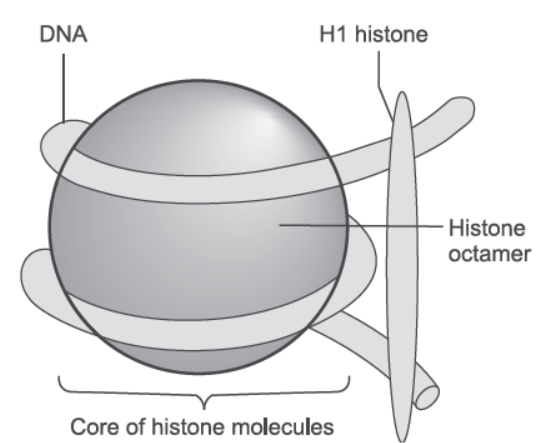
Nucleosome is found in the nucleus of the cell.
Question. (a) What is this diagram representing?
(b) Name the parts a, b and c.
(c) In the eukaryotes, the DNA molecules are organised within the nucleus. How is the DNA molecule organised in a bacterial cell in absence of a nucleus?
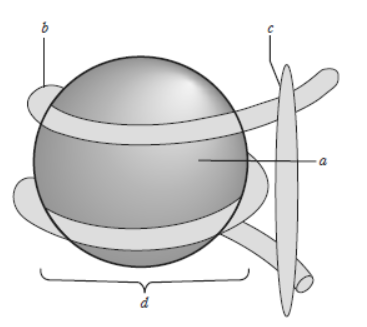
Answer. (a) Nucleosome
(b) a—Histone octamer, b—DNA, c—H1 histone
(c) In bacterial cell, DNA in nucleoid is organised in large loops held together by proteins.
Question. List the salient features of double helix structure of DNA.
Answer. (i) DNA is made up of two polynucleotide chains, where the backbone is made up of sugar and phosphate groups and the nitrogenous bases project towards the centre.
(ii) There is complementary base pairing between the two strands of DNA. ‘A’ pairs with ‘T’ with 2 hydrogen bonds and ‘C’ pairs with ‘G’ with 3 hydrogen bonds.
(iii) The two strands are coiled in right-handed fashion and are anti-parallel in orientation. One chain has a 5′→3′ polarity while the other has 3′→5′ polarity.
(iv) The diameter of the strand is always constant due to pairing of purine and pyrimidine, i.e., adenine is complementary to thymine while guanine is complementary to cytosine.
(v) The distance between two base pairs in a helix is 0.34 nm and a complete turn contains approximately ten base pairs. The pitch of the helix is 3.4 nm and the two strands are righthanded coiled.
(vi) Plane of one base pair stacks over the other in double helix. This in addition to hydrogen bonds confers stability to the helical structure.
(vii) Linkage between nitrogenous base and pentose sugar is N-glycosidic linkage.
Question. It is established that RNA is the first genetic material. Explain giving three reasons.
Answer. The reasons in support are:
(i) Processes like metabolism, translation and splicing evolve around RNA.
(ii) RNA is reactive and catalyses reactions.
(iii) In some viruses, RNA is the hereditary material.
(iv) RNA is unstable and can be easily mutated leading to evolution. (Any three)
Question. A typical mammalian cell has 22 metres long DNA molecule whereas the nucleus in which it is packed measures about 10–6 m. Explain how such a long DNA molecule is packed within a tiny nucleus in the cell.
Answer. Packaging of DNA in eukaryotes
- Roger Kornberg (1974) reported that chromosome is made up of DNA and protein.
- Later, Beadle and Tatum reported that chromatin fibres look like beads on the string, where beads are repeated units of proteins.
- The proteins associated with DNA are of two types— basic proteins (histones) and acidic non-histone chromosomal (NHC) proteins.
- The negatively charged DNA molecule wraps around the positively charged histone proteins to form a structure called nucleosome.
- The nucleosome core is made up of four types of histone proteins—H2A, H2B, H3 and H4 occurring in pairs.
- 200 bp of DNA helix wrap around the nucleosome by 1¾ turns, plugged by H1 histone protein.
- Repeating units of nucleosomes form the chromatin in nucleus, which is a thread-like structure.
- The chromatin is packed to form a solenoid structure of 30 nm diametre.
- Further supercoiling forms a looped structure called the chromatin fibre.
- These chromatin fibres further coil and condense at metaphase stage of cell division to form chromosomes. Packaging of chromatin at higher level requires NHC proteins.
Question. (a) A DNA segment has a total of 1000 nucleotides, out of which 240 of them are adenine containing nucleotides. How many pyrimidine bases this DNA segment possesses?
(b) Draw a diagrammatic sketch of a portion of DNA segment to support your answer.
Answer. (a) A = T, A = 240, hence T = 240
A + T = 240 + 240 = 480
So, G + C = 1000 – 480 = 520
G = C, so C
= 520/2
=260
So, pyrimidines = C + T
= 260 + 240
= 500
(b)
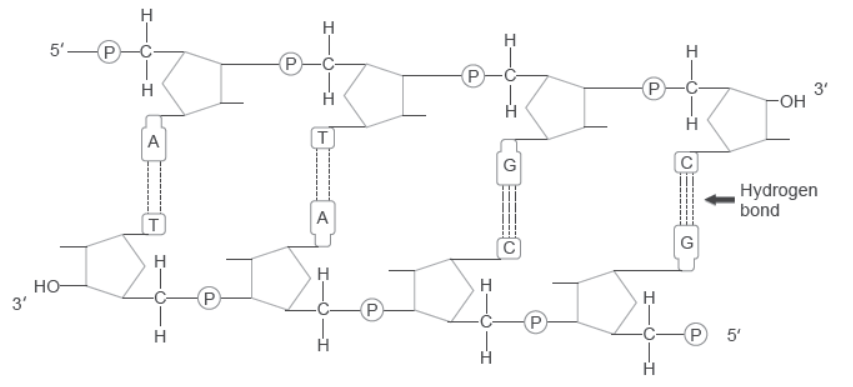
Question. (a) Why did Hershey and Chase use radioactive sulphur and radioactive phosphorus in their experiment?
(b) Write the conclusion they arrived at and how.
Answer. Procedure:
(i) Some bacteriophage virus were grown on a medium that contained radioactive phosphorus
(32P) and some in another medium with radioactive sulphur (35S).
(ii) Viruses grown in the presence of radioactive phosphorus (32P) contained radioactive DNA.
(iii) Similar viruses grown in presence of radioactive sulphur (35S) contained radioactive protein.
(iv) Both the radioactive virus types were allowed to infect E. coli separately.
(v) Soon after infection, the bacterial cells were gently agitated in blender to remove viral coats from the bacteria.
(vi) The culture was also centrifuged to separate the viral particle from the bacterial cell.
- Observations and Conclusions:
(i) Only radioactive 32P was found to be associated with the bacterial cell, whereas radioactive 35S was only found in surrounding medium and not in the bacterial cell.
(ii) This indicates that only DNA and not the protein coat entered the bacterial cell.
(iii) This proves that DNA is the genetic material which is passed from virus to bacteria and not protein.
Question. Answer the following questions based on Meselson and Stahl’s experiment:
(a) Write the name of the chemical substance used as a source of nitrogen in the experiment by them.
(b) Why did the scientists synthesise the light and the heavy DNA molecules in the organism used in the experiment?
(c) How did the scientists make it possible to distinguish the heavy DNA molecule from the light DNA molecule? Explain.
(d) Write the conclusion the scientists arrived at after completing the experiment.
Answer. (a) Ammonium chloride (NH4Cl).
(b) To check if DNA replication was semi-conservative.
(c) The heavy and light DNA molecules were distinguished by centrifugation in a caesium chloride density gradient.
(d) The scientists concluded that DNA replicates semi-conservatively.
Question. The base sequence in one of the strands of DNA is TAGCATGAT.
(i) Give the base sequence of its complementary strand.
(ii) How are these base pairs held together in a DNA molecule?
(iii) Explain the base complementarity rules. Name the scientist who framed this rule.
Answer. (i) The complementary strand is ATCGTACTA.
(ii) The base pairs are held together by hydrogen bonds in a DNA molecule. A and T are held by two hydrogen bonds while G and C are held by three hydrogen bonds.
(iii) Watson and Crick framed the base complementarity rule. The rule states that the ratios between adenine and thymine, and guanine and cytosine are constant and equals one.
Question. Describe Frederick Griffith’s experiment on Streptococcus pneumoniae. Discuss the conclusion he arrived at.
OR
Describe the experiment with Streptococcus pneumoniae that demonstrated the existence of some “transforming principle”.
Answer.
- Frederick Griffith (1928) conducted experiments with Streptococcus pneumoniae (bacterium causing pneumonia).
- He observed two strains of this bacterium—one forming smooth shiny colonies (S-type) with capsule, while other forming rough colonies (R-type) without capsule.
- When live S-type cells were injected into mice, they died due to pneumonia.
- When live R-type cells were injected into mice, they survived.
- When heat-killed S-type cells were injected into mice, they survived and there were no symptoms of pnuemonia.
- When heat-killed S-type cells were mixed with live R-type cells and injected into mice, they died due to unexpected symptoms of pneumonia and live S-type cells were obtained from mice.
- He concluded that heat-killed S-type bacteria caused a transformation of the R-type bacteria into S-type bacteria but he was not able to understand the cause of this bacterial transformation.
- He further stated that some ‘transforming principle’ transferred from heat killed S strain, enabled R strain to synthesize a smooth polysaccharide coat and become virulent. But biochemical nature of genetic material was not defined from his experiments
Question. How was a heavy isotope of nitrogen used to provide experimental evidence to semiconservative mode of DNA replication?
OR
Describe the experiment that helped to demonstrate the semi-conservative mode of DNA replication.
Answer.
Experimental proof for semi-conservative mode of DNA replication
- Matthew Meselson and Franklin Stahl in 1958 performed experiments on E. coli to prove that DNA replication is semi-conservative.
- They grew E. coli in a medium containing 15NH4Cl (in which 15N is the heavy isotope of nitrogen) for many generations.
- As a result, 15N got incorporated into newly synthesised DNA.
- This heavy DNA can be differentiated from normal DNA by centrifugation in caesium chloride (CsCl) density gradient.
- Then they transferred the cells into a medium with normal 14NH4Cl and took the samples at various definite time intervals as the cells multiplied.
- The extracted DNAs were centrifuged and measured to get their densities.
- The DNA extracted from the culture after one generation of transfer from the 15N medium to 14N medium (i.e., after 20 minutes; E. coli divides every 20 minutes) showed an intermediate hybrid density.
- The DNA extracted from culture after two generations (i.e., after 40 minutes) showed equal amounts of light DNA and hybrid DNA.
- When allowed to grow for 80 minutes, it showed more amounts of light DNA but the hybrid DNA still maintained itself.
- Similar experiment was performed by Taylor and colleagues in 1958, on Vicia faba using radioactive thymidine to detect distribution of newly synthesized DNA in chromosomes to prove that the DNA in chromosome also replicate semi-conservatively.
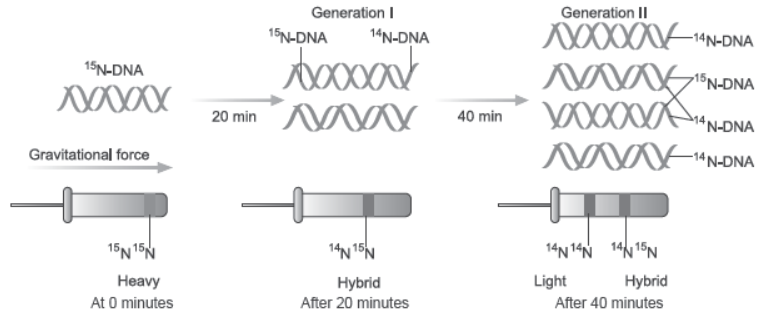
Question. What are the three types of RNA? Mention their relation to protein synthesis.
Answer. Types of RNA
| Types of RNA | Functions |
| Messenger RNA (mRNA) | (i) It stores the genetic information from DNA. (ii) It decides the sequence of amino acid in a polypeptide. |
| Transfer RNA (tRNA) | (i) It acts as an adaptor molecule that at one end reads the code on mRNA and accordingly bind to amino acid on the other end. (ii) It recognises the codon on mRNA by its anticodon and leaves amino acid at the protein synthesis site. |
| Ribosomal RNA (rRNA) | (i) It constitutes the ribosomal structure. (ii) It helps to form peptide bond. |
Question. (a) Differentiate between a template strand and coding strand of DNA.
(b) Name the source of energy for the replication of DNA.
Answer.
| Template strand | Coding strand |
| It is the strand of DNA which takes part in transcription. | It is the strand that does not take part in transcription. |
| The polarity is 3′→5′. | The polarity is 5′→3′. |
| Nucleotide sequence is complementary to the one present in mRNA. | The nucleotide sequence is same as the one present in mRNA except for presence of thymine instead of uracil. |
(b) Deoxynucleoside triphosphates provide the energy for DNA replication.
Question. State any two structural differences and one functional difference between DNA and rRNA.
Answer.
| DNA | rRNA |
| Structural differences | |
| It is a double-stranded structure. | It is a single-stranded structure. |
| It contains nitrogen bases, A, T, G, C. | It contains nitrogen base, A, U, G, C. |
| It has deoxyribose sugar. | It has ribose sugar. |
| Functional difference | |
| It determines sequence of amino acid in a polypeptide by transcription and passes information from one generation to another. | It is the site of translation. |
Question. DNA polymerase and RNA polymerase differ in their requirement while functioning.
Explain.
Answer.
| RNA polymerase | DNA polymerase |
| It cannot carry out proofreading. | It carries out proofreading for DNA repair mechanism. |
| RNA polymerase does not require RNA primer for synthesis of RNA. | DNA polymerase requires RNA primer for synthesis of DNA. |
| It uses ribonucleotides for RNA synthesis. | It uses deoxyribonucleotides for DNA synthesis. |
Question. Draw a labelled schematic sketch of replication fork of DNA. Explain the role of the enzymes involved in DNA replication.
Answer.
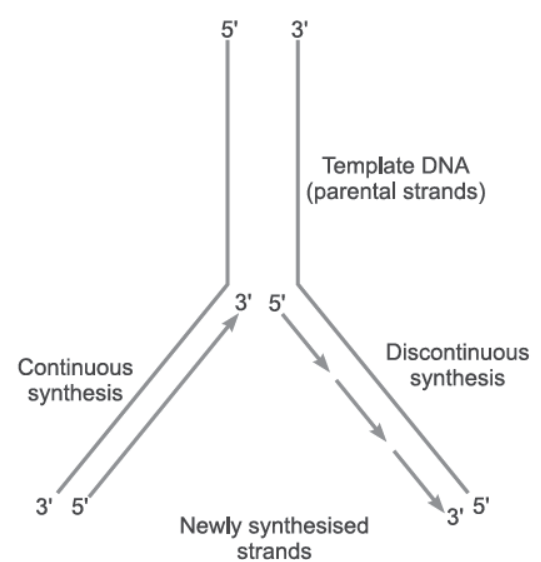
Enzymes involved in DNA replication are:
(i) DNA-dependent DNA polymerase, which catalyses the polymerisation of polynucleotides in a very short time only in 5′→3′ direction with accuracy.
(ii) DNA ligase, which joins the discontinuously synthesised short segments called Okazaki fragments formed on one of the template strands.
Question. (a) Draw a schematic representation of the structure of a transcription unit and show the following in it:
(i) Direction in which the transcription occurs
(ii) Polarity of the two strands involved
(iii) Template strand
(iv) Terminator gene
(b) Mention the function of promoter gene in transcription.
Answer. (a) (i) Transcription occurs in 5′→3′.

b) Promotor gene has DNA sequence that provide binding site for RNA polymerase.
Question. Describe the initiation process of transcription in bacteria.
Answer. In bacteria, the transcription of all the three types of RNA (mRNA, tRNA, rRNA) is catalysed by single DNA-dependent enzyme called the RNA polymerase. The RNA polymerase has cofactors that catalyse the process. During initiation, s (sigma) factor recognises the start signal and promotor region on DNA which then along with RNA polymerase binds to the promoter to initiate transcription.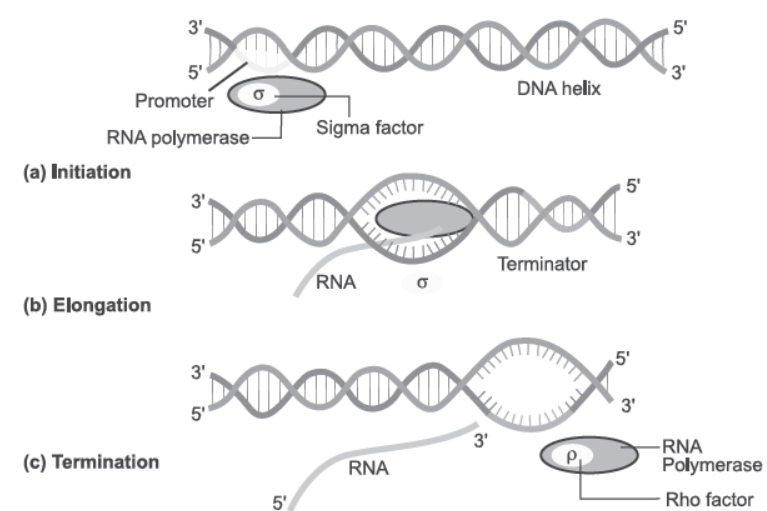
| CBSE Class 12 Biology Sexual Reproduction In Flowering Plants VBQs |
| CBSE Class 12 Biology Human Reproduction VBQs |
| CBSE Class 12 Biology Reproductive Health VBQs |
| CBSE Class 12 Biology Principles of Inheritance and Variation VBQs |
| CBSE Class 12 Biology Molecular Basis of Inheritance VBQs |
| CBSE Class 12 Biology Evolution VBQs |
| CBSE Class 12 Biology Human Health and Diseases VBQs |
| CBSE Class 12 Biology Microbes in Human Welfare VBQs |
| CBSE Class 12 Biology Biotechnology Principles and Processes VBQs |
| CBSE Class 12 Biology Biotechnology and Its Application VBQs |
| CBSE Class 12 Biology Organisms and Populations VBQs |
| CBSE Class 12 Biology Ecosystem VBQs |
| CBSE Class 12 Biology Biodiversity and Conservation VBQs |
| CBSE Class 12 Biology Reproduction in Organisms VBQs |
| CBSE Class 12 Biology Strategies for Enhancement in Food Production VBQs |
VBQs for Chapter 5 Molecular Basis of Inheritance Class 12 Biology
We hope students liked the above VBQs for Chapter 5 Molecular Basis of Inheritance designed as per the latest syllabus for Class 12 Biology released by CBSE. Students of Class 12 should download the Value Based Questions and Answers in Pdf format and practice the questions and solutions given in above Class 12 Biology VBQs Questions on daily basis. All latest VBQs with answers have been developed for Biology by referring to the most important and regularly asked topics which the students should learn and practice to get better score in school tests and examinations. Expert teachers of studiestoday have referred to NCERT book for Class 12 Biology to develop the Biology Class 12 VBQs. After solving the questions given in the VBQs which have been developed as per latest course books also refer to the NCERT solutions for Class 12 Biology designed by our teachers. We have also provided a lot of other VBQs for Class 12 Biology which you can use to further make yourself better in Biology.
You can download the CBSE VBQs for Class 12 Biology Chapter 5 Molecular Basis of Inheritance for latest session from StudiesToday.com
Yes, the VBQs issued by CBSE for Chapter 5 Molecular Basis of Inheritance Class 12 Biology have been made available here for latest academic session
There is no charge for the VBQs and their answers for Class 12 CBSE Biology Chapter 5 Molecular Basis of Inheritance you can download everything free
Regular revision of VBQs given on studiestoday for Class 12 subject Biology Chapter 5 Molecular Basis of Inheritance can help you to score better marks in exams
Value Based Questions (VBQs) for Class 12 Biology Chapter 5 Molecular Basis of Inheritance help to test the ability of students to apply learnings to various situations in life.

